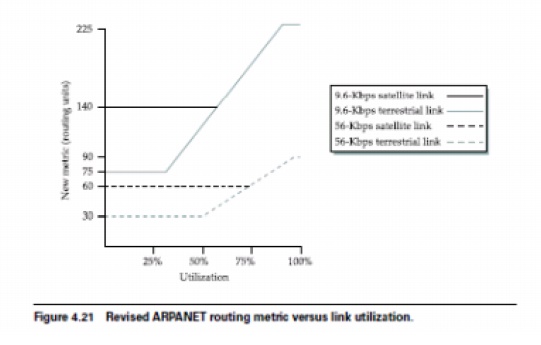Chapter: Computer Networks : Routing
Metrics
METRICS
The
preceding discussion assumes that link costs, or metrics, are known when we
execute the routing algorithm. In this section, we look at some ways to
calculate link costs that have proven effective in practice. One example that
we have seen already, which is quite reasonable and very simple, is to assign a
cost of 1 to all links—the least-cost route will then be the one with the
fewest hops. Such an approach has several drawbacks, however. First, it does
not distinguish between links on a latency basis. Thus, a satellite link with
250-ms latency looks just as attractive to the routing protocol as a
terrestrial link with 1-ms latency. Second, it does not distinguish between
routes on a capacity basis, making a 9.6-Kbps link look just as good as a
45-Mbps link. Finally, it does not distinguish between links based on their
current load, making it impossible to route around overloaded links. It turns
out that this last problem is the hardest because you are trying to capture the
complex and dynamic characteristics of a link in a single scalar cost.
The
ARPANET was the testing ground for a number of different approaches to
link-cost calculation. (It was also the place where the superior stability of
link-state over distance-vector routing was demonstrated; the original
mechanism used distance vector while the later version used link state.) The
following discussion traces the evolution of the ARPANET routing metric and, in
so doing, explores the subtle aspects of the problem.
The
original ARPANET routing metric measured the number of packets that were queued
waiting to be transmitted on each link, meaning that a link with 10 packets
queued waiting to be transmitted was assigned a larger cost weight than a link
with 5 packets queued for transmission. Using queue length as a routing metric
did not work well, however, since queue length is an artificial measure of
load—it moves packets toward the shortest queue rather than toward the
destination, a situation all too familiar to those of us who hop from line to
line at the grocery store. Stated more precisely, the original ARPANET routing
mechanism suffered from the fact that it did not take either the bandwidth or
the latency of the link into consideration.
A second
version of the ARPANET routing algorithm, sometimes called the “new routing
mechanism,” took both link bandwidth and latency into consideration and used
delay, rather than
just
queue length, as a measure of load. This was done as follows. First, each
incoming packet was timestamped with its time of arrival at the router
(ArrivalTime); its departure time from the router (DepartTime) was also
recorded. Second, when the link-level ACK was received from the other side, the
node computed the delay for that packet as
Delay = (DepartTime− ArrivalTime) +TransmissionTime +Latency
where
TransmissionTime and Latency were statically defined for the link and captured
the link’s bandwidth and latency, respectively. Notice that in this case,
DepartTime − ArrivalTime represents the amount of time the packet was delayed
(queued) in the node due to load. If the ACK did not arrive, but instead the
packet timed out, then DepartTime was reset to the time the packet was retransmitted. In this case, DepartTime
− ArrivalTime captures the reliability of the link—the more frequent the
retransmission of packets, the less reliable the link, and the more we want to
avoid it. Finally, the weight assigned to each link was derived from the
average delay experienced by the packets recently sent over that link.
· A highly
loaded link never shows a cost of more than three times its cost when idle;
· The most
expensive link is only seven times the cost of the least expensive;
· A
high-speed satellite link is more attractive than a low-speed terrestrial link;
· Cost is a
function of link utilization only at moderate to high loads.

Related Topics